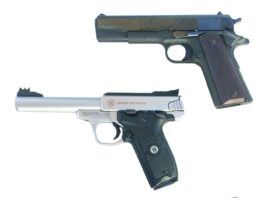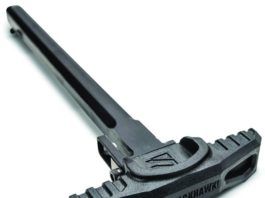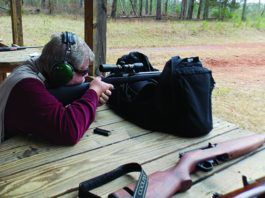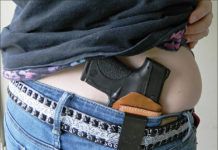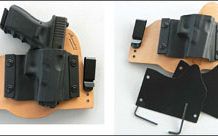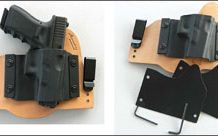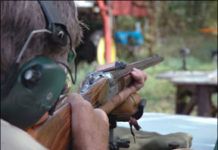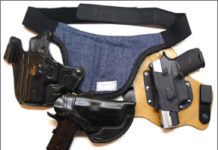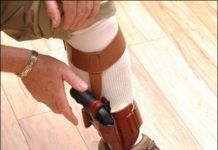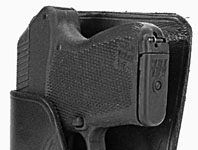Hot-Weather Carry: Talon IWB, Ted Blocker S18 Are Best Buys
Inside-The-Waistband Holsters: Kydex, Leather, & Hybrid Styles
Inside-The-Waistband Holsters: Kydex, Leather, & Hybrid Styles
Options for Concealed Carry: Two Nines Vs. a Forty Wheelgun
When it comes to concealing a handgun, there is only so much space available on the hip, inside a handbag, or somewhere else on the body or in clothing. That's why there are snubnosed revolvers and subcompact pistols. Choosing a handgun, then, becomes a balance of firepower versus weight and overall structural dimensions. In this test, we will limit the size of our test guns to three guns that will fit into a box approximately 5-by-7 inches in size — which represents a handgun that can be carried easily in just about any manner of traditional concealment.
However, we are purposefully mixing apples and oranges, that is, pistols and revolvers, because either design can do the job of self-protection at close range. Our three test guns were the $747 9mm Kimber Solo Carry, the $299 9mm SCCY Industries CPX-2, and the $523 Taurus 40 S&W M405 stainless-steel revolver. Each gun offered at least one advantage not shared by the other two. The Kimber Solo was the most concealable. The SCCY pistol offered the highest capacity, and the Taurus revolver fired the biggest bullet.
The cartridge versus cartridge debate rages on, largely based on the stopping power of one single shot. But let us offer an alternative viewpoint suggested by TacPro Shooting Center's Bill Davison. Davison, a former Royal Marine and one of the most complete training consultants in the United States, offers that when rating the firepower of a handgun, the amount of energy it can deliver should be the sum of its entire capacity rather than the energy of one lone shot. For example, a 9+1 capacity pistol, wherein each bullet registers about 330 foot-pounds of energy at the muzzle, should ultimately be considered more powerful than a six-shot pistol that fires ammunition capable of delivering 500 foot-pounds with each round of fire. Food for thought.
For our tests, we began by shooting five-shot groups (the capacity of the Taurus) from the 15-yard bench. Then, we applied what we think was a more realistic test. Each gun was fired from a distance of 5 yards at a humanoid paper target. Start position was with the gun lowered to rest on a oil-barrel top about waist high. We used a CED8000 shot-activated timer to provide a start signal and record elapsed time of each shot. We took note of the first shot to see how fast we could get the gun into action and the last shot to see how long it took to deliver two shots to center mass and one shot to the head area. Altogether we recorded five separate strings of fire. We scored the hits A, B, C, or D, looking for ten hits to the preferred 5.9-inch by 11.2-inch A-zone at center mass and five hits to the A-zone in the head, which measured 4 inches long by 2 inches high. The catch was that the test was performed strong hand only. (By a right-handed shooter holding the gun with only his right hand). We weren't trying to be cowboys or go Hollywood. It's just that in close-range fighting where guns such as these would most likely be used, applying a support hand may not be possible. On the semiautos, there wasn't much room for a support hand in the first place.
For testing the Taurus revolver, we chose Winchester 165-grain FMJ ammunition sold in a value pack, Federal Premium 135-grain Hydra Shok JHP ammunition, and Hornady Custom 180-grain XTP jacketed hollowpoint rounds. The 165-grain rounds were also used in our action shooting test. For testing the semi-automatics, we ended up using four test rounds. After testing with 115-grain FMJ, 115-grain JHP EXP hollowpoints, and 124-grain JHP rounds from Black Hills Ammunition, we learned that Kimber had declared that the Solo should only be used with 124-grain and 147-grain bullets. So, we went back to the test range with a supply of Federal 147-grain Federal Hydra Shok ammunition and resumed our bench session. Naturally, we retested the SCCY pistol with the 147-grain ammunition as well. All test rounds were standard pressure, including the Black Hills EXP ammunition, which was designed for maximum performance in firearms not recommended for +P ammunition. Here is what we learned.
Sabatti 450/400: Affordable Double Rifle, Perfect Caliber
A double rifle for $5500? It can't be very good, we thought, when our neighbor phoned us to tell us he had just bought an Italian Sabatti Model 92 Deluxe rifle, new from Cabela's for that price, in caliber 450/400.
The cartridge is an excellent one for double rifles. It's known as the 450/400 3-inch or the 400 Jeffery. There is also a 3.25-inch version that was originally a blackpowder cartridge, but the 3-inch version was never factory loaded with black powder. It is one of the lower-pressure British cartridges, along with the 470 and 360 No. 2, and thus is an excellent choice for a double rifle, especially if it's to be used in extreme heat. The cartridge was one of the more popular all-around cartridges for hunting use when it was introduced in 1902. Its popularity suffered when the 375 H&H Magnum came along a few years later, but the 400 Jeff throws a heavier bullet, 400 grains versus 300, and some hunters prefer that.
We went to look at our neighbor's rifle, and then arranged to shoot it. What follows are our impressions and observations of what we now consider to be a bargain.
IWB Holsters: Kramer Leather Tans The Hide Of Competitors
Ankle-Holster Carry Choices: We Think Rugers LCR is A-OK
Is Pocket Carry Safe? Getting A Hold on Pocket Holsters
Carrying a pistol in a pocket requires that the gun be disguised, secure, and protected. Can two holsters achieve this hat trick?



























